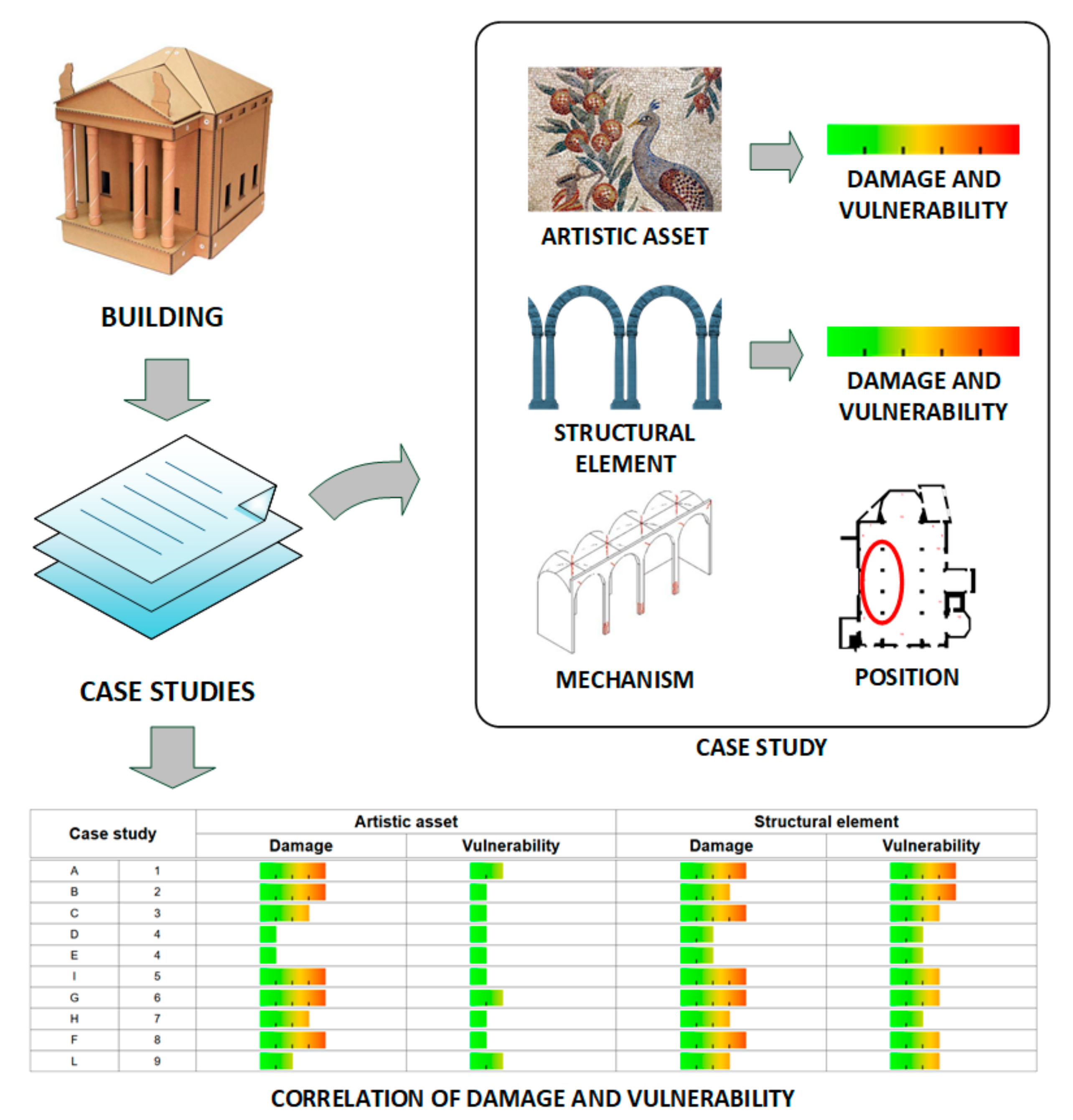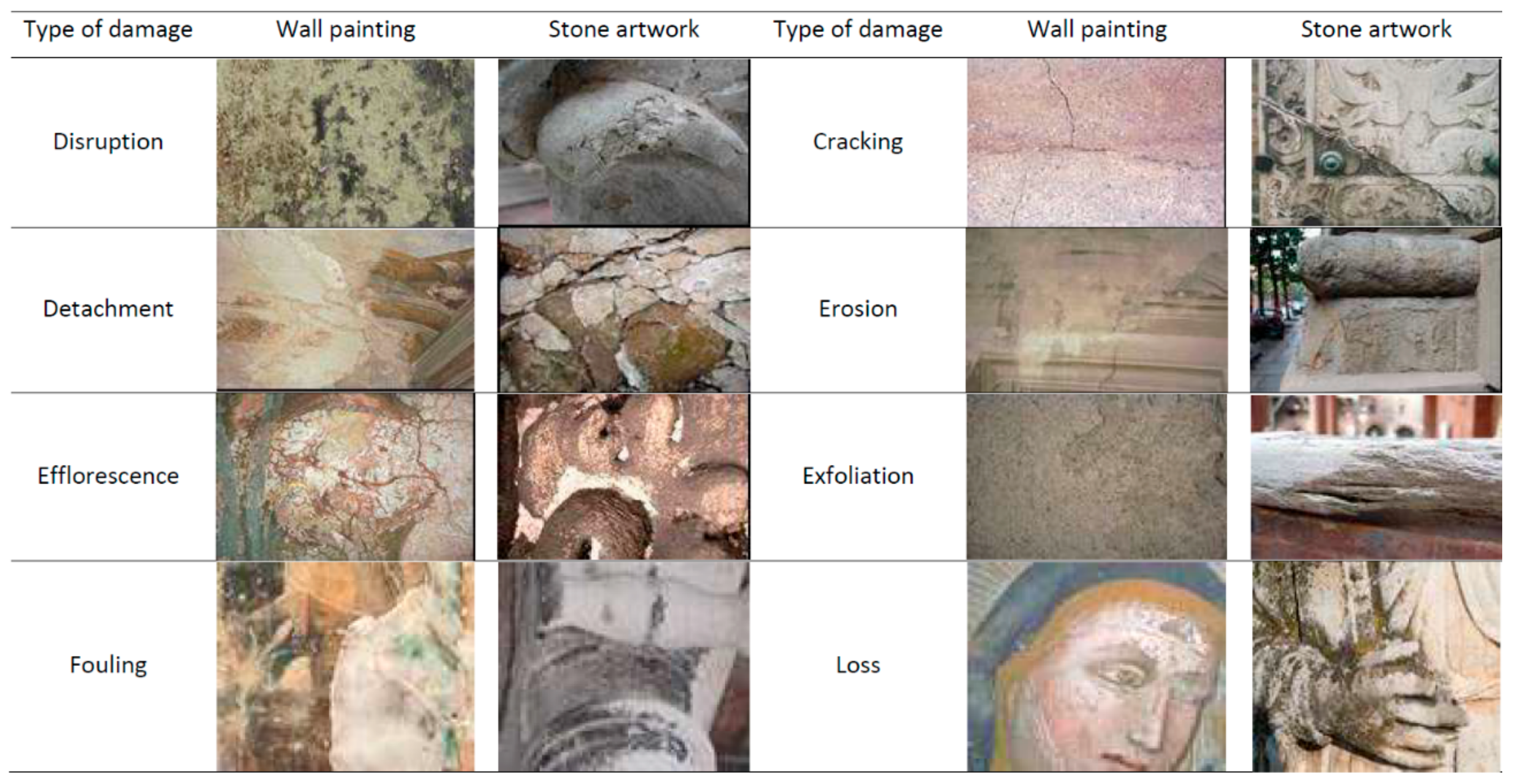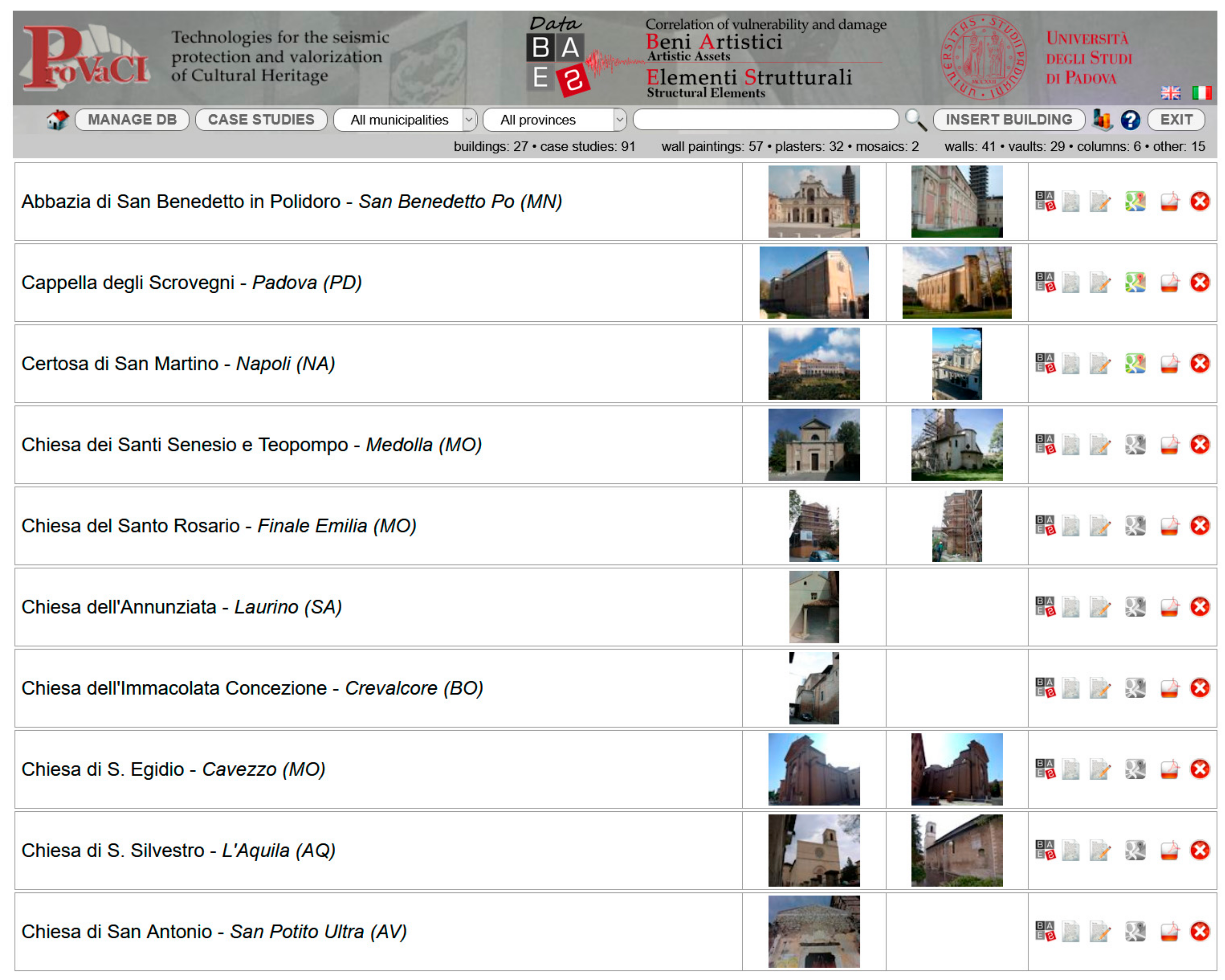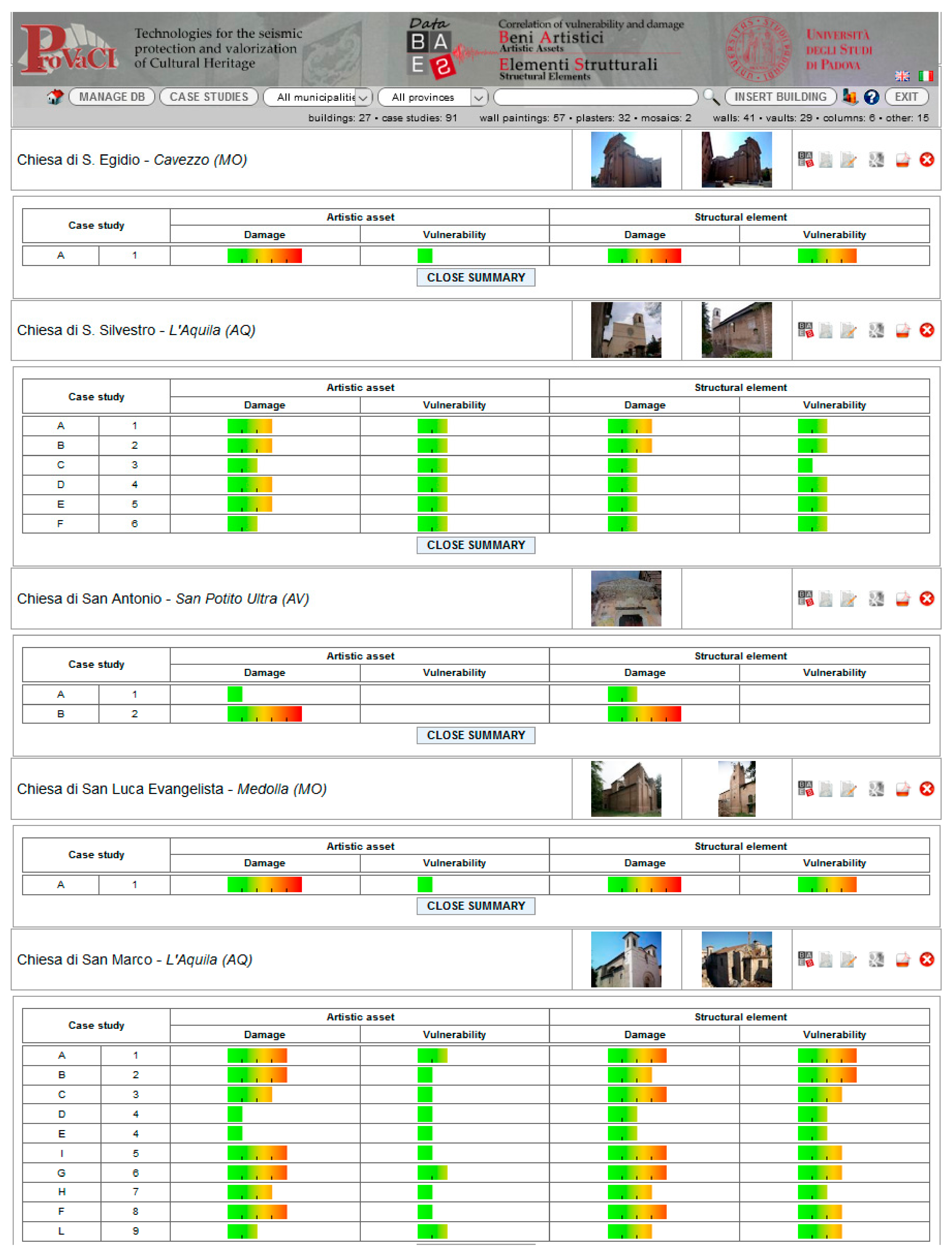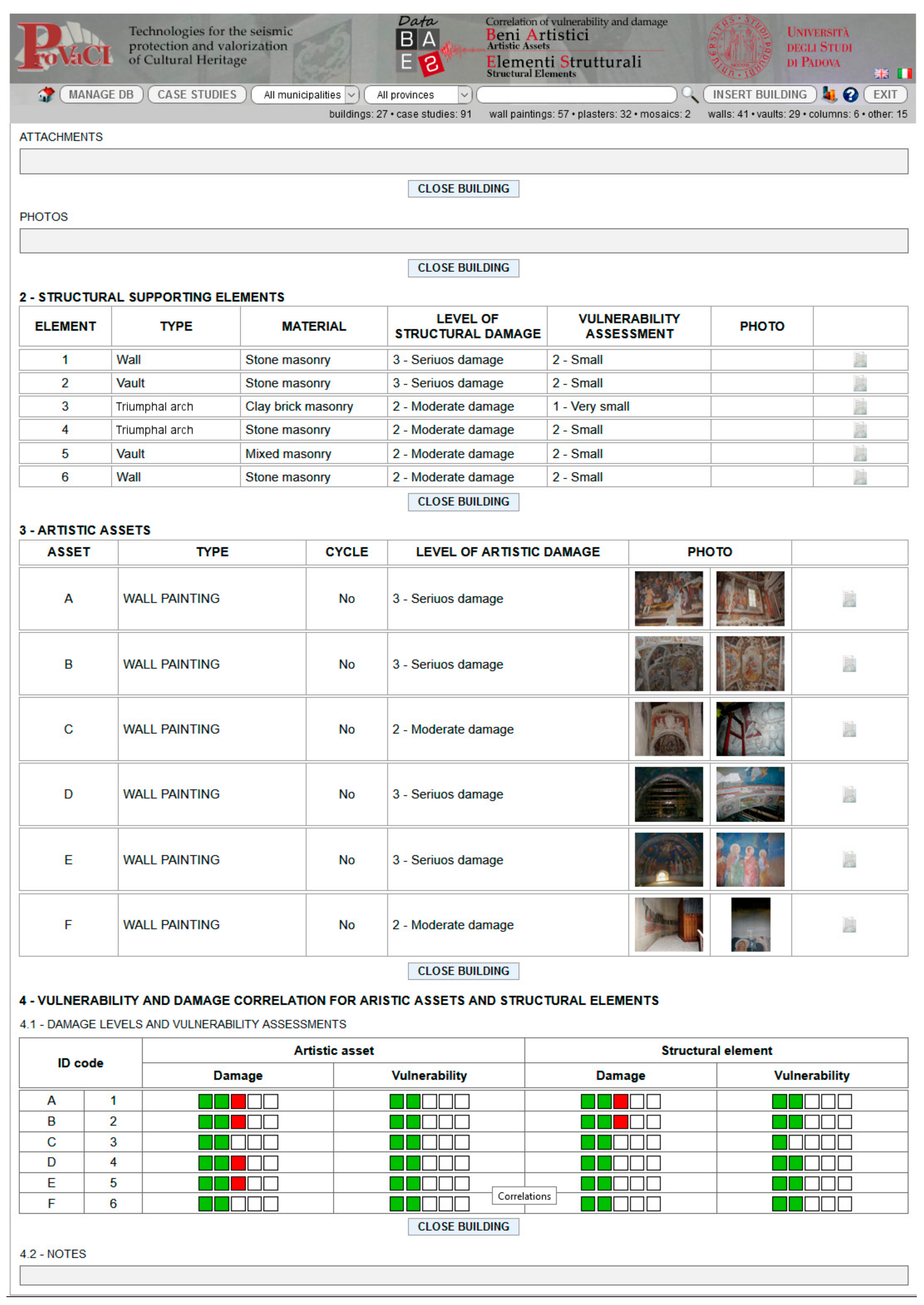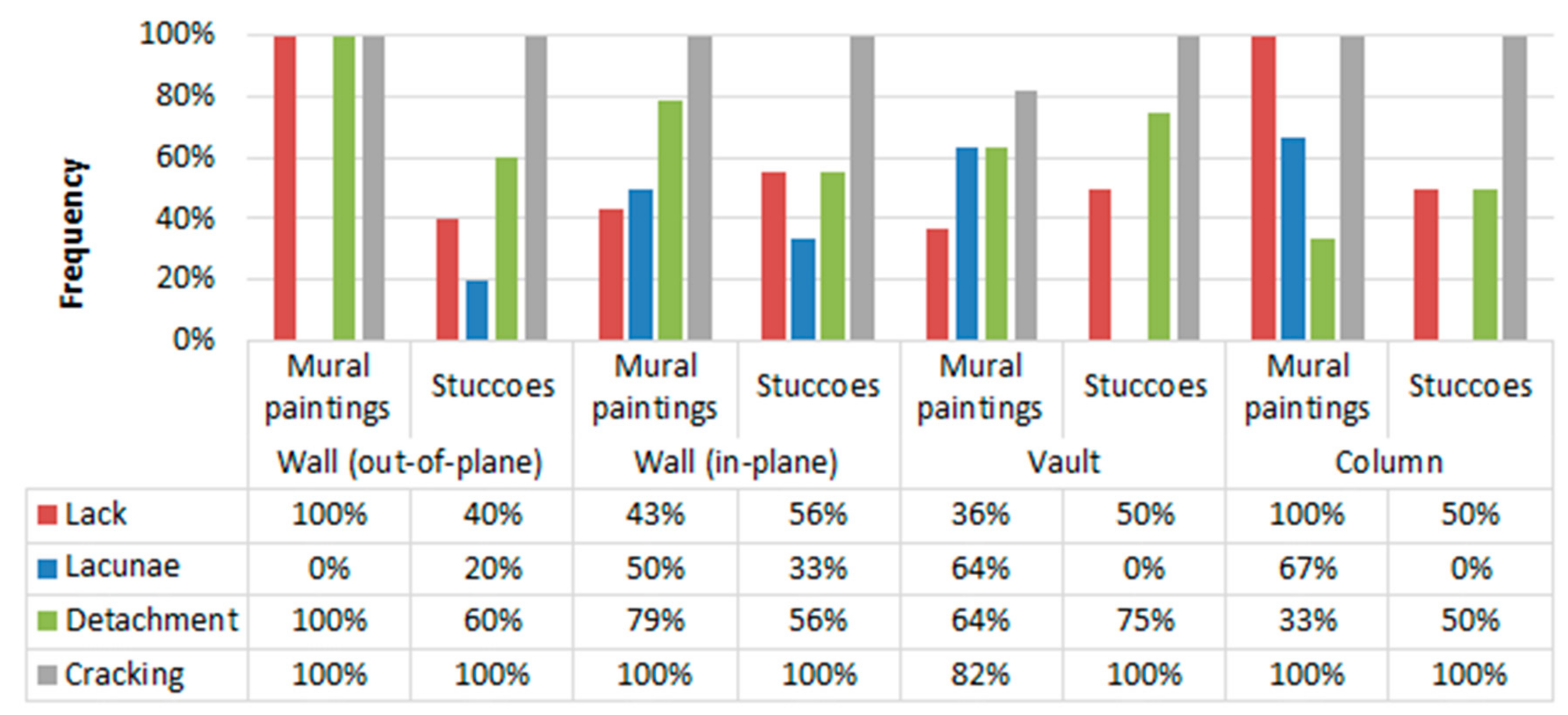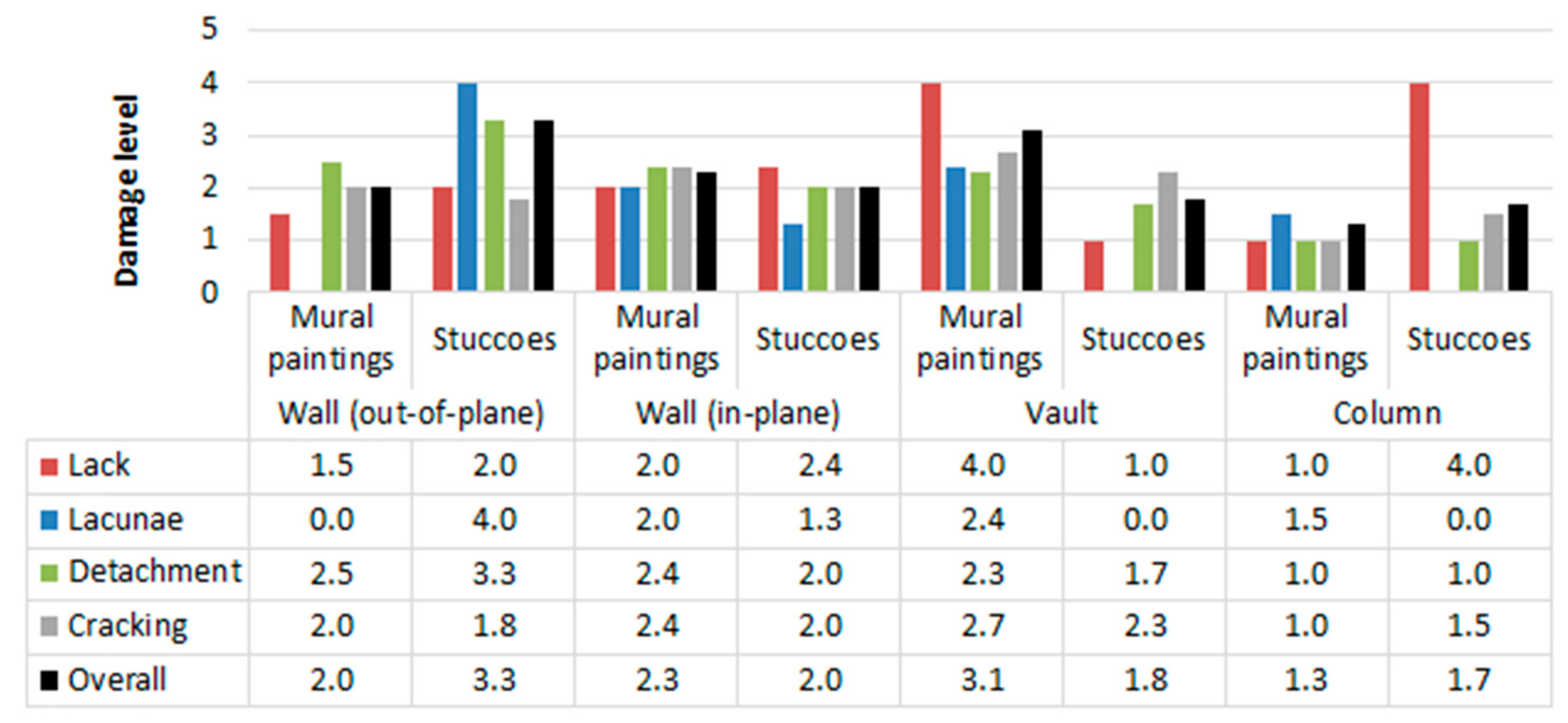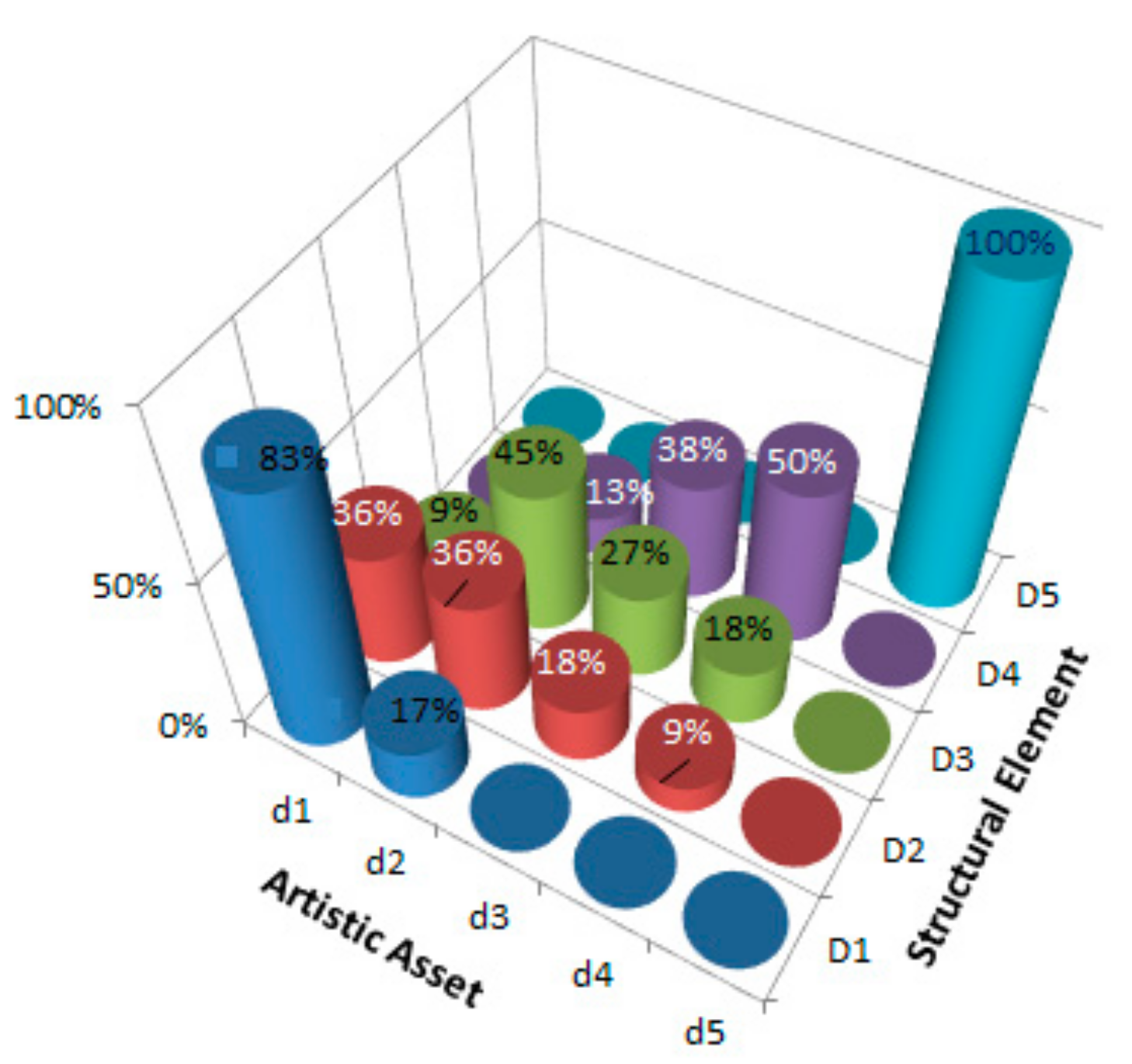1. Introduction
Masonry buildings in historic city centres are recognised as being structures that are prone to damage from earthquakes due to vulnerabilities associated with their architectural type (e.g., church, palace, tower) as well as specific constructional aspects (e.g., the quality of materials, construction details, connections) and current state conditions (e.g., decay, previous interventions). The concurrence of these factors can cause severe damage scenarios and losses of cultural heritage (CH) assets even under medium-intensity earthquakes, as demonstrated by several episodes of seismic activity in Italy in recent decades (e.g., 1997 Umbria-Marche, 2009 L’Aquila, 2016 Central Italy earthquakes) [
1,
2].
A post-earthquake emergency in historical city centres often requires the implementation of safety measures for unmovable artistic assets, i.e., those which are integral to damaged structural components. This is the case with the frescoes, decorated plasters, mural paintings, mosaics and stuccoes, which are supported by vaults, columns, ceilings, or walls of a historical building [
3,
4]. This phase involves both structural engineers and experts on the preservation of CH assets, who usually can make decisions based on the compliance with safety conditions according to their specific knowledge (i.e., on the artistic asset or the structure) and suggest appropriate actions if necessary. Nevertheless, due to the close interconnection between the artwork and its structural support, the evaluation of the current conditions of the former heavily depends on the latter, whose worsened conditions can jeopardise the safety of the whole building.
As an example, a typical severe and, unfortunately, common condition is that of a fresco borne by a wall that has no constraints (e.g., ties, effective connections with adjacent walls and the floor/roof) to counteract overturning under seismic loads, or has low masonry quality (e.g., multi-leaf rubble section). The fresco is in the highest risk condition, because the structural element (the wall to which the fresco is connected) behaves according to the weakest and most brittle mechanism (i.e., out-of-plane collapse) (
Figure 1a). On the contrary, in a building where the activation of overall behaviour is provided by more earthquake-resistant conditions, limited structural damage is expected (e.g., in-plane shear cracking in a wall), although it can provide severe patterns, which could affect the fresco integrity (
Figure 1b).
Studies on the correlation of damage between artistic assets (AA) and structural elements (SE) are very limited in literature, especially if related to historic/traditional materials (e.g., plasters). Calderini et al. [
5] examined the mechanical interaction between stone masonry panels and covering plasters simulating frescoes by either diagonal compression or shear tests, integrated by non-destructive techniques (NDT, e.g., infrared thermography and ground-penetrating radar). The study highlighted the damage propagation from the wall to the plaster and contributed to the definition of the limit states of plaster regarding the condition of the SE. Valluzzi et al. [
6] measured the overall interaction between a fresco and its supporting wall under laboratory compression tests. Various plasters (in terms of composition and finishing quality) applied to the surfaces of a rubble stone masonry panel were taken into consideration, and laser scanning and infrared thermography were also applied to monitor the damage progression during loading. The test caused surface detachments and spalling, which was limited in the plaster that complied with better application criteria. Both studies highlighted the high fragility of plasters in terms of either in-plane or out-of-plane behaviour. More contributions in literature concern the application of NDT for the evaluation of the conservation conditions of CH assets [
7,
8,
9,
10], or are mainly focused on modern render products, both in terms of the theoretic approach of elasticity applied to multi-layer systems [
11] and of the effect of weathering on durability [
12,
13]. A significant contribution aimed at supporting the design of strengthening interventions for the preservation of architectural buildings comes from comprehensive EU research, e.g., PERPETUATE [
14,
15] and NIKER [
16] projects. The former included the study of buildings with the contained artworks, and the latter provided guidelines for strengthening actions in the form of a structured web catalogue [
17]. Recent developments in web-based tools [
18] also provide decision-making processes in assessing failure modes through the observation of post-earthquake scenarios.
Nevertheless, at present, while the knowledge of the mechanical behaviour of structural components has been clarified by several studies and has been supported by reliable evaluation procedures (for both damage and vulnerability aspects), there are not yet any prediction tools encompassing the vulnerability of artworks. In particular, the parameters affecting the combined behaviour between AA and SE need to be identified, and their mutual influence must be properly quantified to optimise integrated and all-encompassing solutions for historic buildings in seismic zones.
Therefore, there is a need for a comprehensive procedure, to use contextually among different areas of expertise, which can encompass both specific aspects related to single issues of both AA and SE and to combine their evaluations. With this aim in mind, an extensive interdisciplinary research was carried out between the University of Padova and the Venetian Cluster. The research focused on the proposal of an integrated approach that was able to take into consideration architectural (for structural elements) and compositional (for artistic assets) details, as well as the critical aspects related to execution or deterioration/damage conditions. This information was structured in a web database (called DataBAES) so that both aspects of vulnerability and damage in a building may be correlated between artworks and their specific supporting structural components.
The procedure provides a multilevel approach through two survey forms, which are to be used for basic (level I form) or deeper (level II one) onsite visual inspections. The level I form provides the correlation of damage between AA and SE, whereas at level II, both the correlation of damage and vulnerability are proposed. Level II corresponds to an in-depth autopsic analysis to understand the state of conservation of the artworks and the bearing structure, as well as to the possibility of carrying out further studies (e.g., in terms of the quality and quantity of present salts, biological attacks, as well as the presence of ‘bottaccioli’ or ‘calcinaroli’). Of course, particularly at level II, ND procedures (e.g., the above-mentioned georadar, infrared thermography, and laser scanning) can be used to help in the identification of the aspects and parameters (in relation to both materials and structure) needed in the following phases of investigation, according to a more detailed knowledge plan.
The applicability of levels I or II might correspond to different conditions, respectively, e.g., (i) the surveying of emergency conditions for preliminary and quick evaluations just after the earthquake occurrence, or (ii) as a predictive tool, focused on collecting data before an event on each possible mechanism of the various SE and related AA. The results are correlated in terms of five degrees of vulnerability/damage (increasing from the lowest to the highest) to provide prioritisation in the possible interventions for the building. Furthermore, according to information collected on various buildings in a certain area through DataBAES, prioritisation evaluations can be extended on a wider scale to integrate possible conservation plans.
The basic reference for the new procedure consists of the survey forms currently applied in Italy, specifically to churches (form A-DC) [
19], palaces (form B-DP) [
20], and artistic assets (form C-BM) [
21] in the emergency post-earthquake phases, as well as the recommendation/classification charts available for evaluating surface decay [
22,
23] and structural damage (EMS-98, European Macro Seismic Scale) [
24].
The procedure was applied to case studies in various conditions for its validation. At present, the archive includes about 100 case studies (i.e., evaluated AA) belonging to about 30 historic masonry buildings. Results are provided in either quick or more extended charts/summaries, including main pictures and descriptions, which can be easily exported in common formats (e.g., pdf documents) for further elaborations.
2. The DataBAES Archive
‘DataBAES’ is a web archive created within the framework of the Italian project ProVaCi (‘Technologies for the Seismic Protection and Valorisation of Cultural Heritage’, 2011–2015 [
25]) aimed at promoting multi-disciplinary actions for the seismic protection and valorisation of cultural heritage, this term meaning an integrated and broad extent of assets. The tool correlates the vulnerability and damage aspects between artistic assets and their supporting architectural components for a given historical building that is either exposed to seismic risk or has already been damaged by an earthquake. The acronym BAES stands for the Italian words ‘Beni Artistici’ (BA) and ‘Elementi Strutturali’ (ES), i.e., ‘artistic assets’ and ‘structural elements’, respectively.
DataBAES was developed in PHP and JavaScript with a MySQL DBMS backend. Its content is available at
https://databaes.dicea.unipd.it/ [
26] to registered users. Registration is free of charge and is open to students, scientists, and researchers who deal with historical and cultural heritage preservation.
The archive structure is based on survey forms representing two levels of investigation for historical and cultural heritage assets, i.e., the “Evaluation and correlation of damage of unmovable artistic assets and structural elements” and “Evaluation and correlation of damage and vulnerability of unmovable artistic assets and structural elements”, respectively. These new forms are included in the
Supplementary Materials of this paper. Each form refers to a specific building. Each building contains one or more case studies, each of which are defined by the following four components: the artistic asset, its supporting structural component, a possible failure mechanism for the structural element, and its localisation within the building. Artistic assets are defined by a sequence of capital letters (i.e., A … Z, …), whereas structural elements are defined by integers (1 … N), so that each case study is identified by a letter-number label (i.e., A1, B2, C3, …). In case of two artworks borne by the same macro-element (e.g., a fresco in a stucco frame against a wall), the two AA will be connected to the same SE by using, as an example, A1 and B1 (for the fresco and the stucco, respectively).
The forms are composed of the following four sections: (1) general information on the building and identification of the significant case studies (AA related to SE); (2) a survey of the damage and vulnerability of the architectural components; (3) a survey of the damage and vulnerability of the artworks; (4) a schematic of the concise judgment of the damage and vulnerability for the list of case studies in the building in question. Sections 1 and 4, being the introductory and the conclusive parts, respectively, have a grey background. This distinguishes them from the two central sections, which can be replicated for the number of case studies identified in the same building.
The options for items that relate to damage and vulnerability aspects are square or round check boxes, which correspond to multiple or single choice, respectively. Detailed degrees of vulnerability and damage are inserted by users, while the average levels are automatically calculated by the system according to given algorithms and/or evaluation scales.
As a result, a table with an overview of the correlation of vulnerability and damage between AA and SE is generated for each building; a scale of colours of five degrees, from green to red, indicates the increasing condition (of damage and vulnerability), so that the most critical artistic assets can be identified and prioritisation measures may be applied if necessary. Levels equal to or greater than three indicate that an emergency threshold has been passed for specific actions to apply to AA and/or SE.
Figure 2 shows the process flow diagram of the archive.
2.1. Structural Element Data
The evaluation of the seismic behaviour of structural components in masonry buildings is based on the macro-element approach, which means on the identification of architectural portions of the building ‘characterised by a substantial autonomous structural response’ [
27] compared to the whole building. Macro-elements are defined on the basis of archive documentation and constructive investigations, and are often recognised as typical architectural elements (e.g., for a church: façade, apse, bell-tower, triumphal arch, etc.). In fact, in the absence of good connections (both wall-to-wall and wall-to-floor/roof), sufficient stiffness of the horizontal components, and regularity (both at geometric and behavioural level), the masonry building cannot activate the ideal ‘box-like’ behaviour, and single brittle rigid body mechanisms can occur, mainly out-of-plane (the so called ‘mode 1’). These mechanisms can provoke severe losses (also related to supported artworks) and collapses, before any in-plane (‘mode 2’) behaviour can be activated [
28,
29]. Nevertheless, a primary fundamental condition to be checked is the presence of possible indicators of masonry quality [
30], as brittle masonry disaggregation (the so called ‘mode 0’, [
31]) can occur before any other mechanisms. Evidently, a low masonry quality also severely affects the safety and integrity of the artworks that are integral to the architectural element, even with a very low seismic hazard.
With regards to the SE, the new survey forms collect values as optimized parameters derived from the church and palace damage forms [
19,
20]. Levels I and II differ for the type and extension of information, so that they can support quick or more extensive onsite evaluations, respectively. The case study, as named in the forms, is the AA, to which the various conditions of the connected SE are considered. Both damage and vulnerability indicators are included, as follows.
At first, the building in question is identified, and the possible availability of previously filled forms (the aforementioned forms for churches and palaces) regarding a specific earthquake can be mentioned.
At level I, the AA and its related SE are identified only with their localisation in the building. Then, each SE (e.g., wall, column, vault, or other) is described in terms of masonry type (material and dimensions, the latter could be measured or estimated) and with the identification of the main damage mechanisms, the origin (i.e., due to seismic action, pre-existing, or simply because of deterioration) and importance (i.e., either primary or secondary) of which should be specified. The possible mechanisms are listed as selected items from the form available for churches (28 mechanisms) and for palaces (22 mechanisms), and the damage level is identified on a scale of 1 to 5, according to the EMS-98.
Figure 3 and
Figure 4 show the damage mechanisms included in the DataBAES forms, and the five damage levels as provided by EMS-98, respectively.
For the primary mechanisms, additional data can be provided about in-plane or out-of-plane damage details for walls (e.g., overturning activation, spalling, crushing, or collapse), as well as about the extension of potential cracking for vaults and columns. Details on cracking are also included, since these can affect the integrity of the AA in terms of extension and type (crazing, passing through, rough estimation of crack opening, etc.). At level I, damage evaluation is predominant, hence the presence of vulnerability indicators and of earthquake-proof devices is simply declared and kept as an overall recognition of potential additional issues for the building.
At level II, the form requires the identification of the AA and its related SE with the primary or secondary mechanism having already been identified (
Figure 5). In fact, at this level, each of the 28 mechanisms for churches or the 22 mechanisms for the other types of buildings are analysed in detail, both in terms of damage and the presence of specific vulnerability/devices. In the case of non-structural elements supporting artworks (e.g.,
camorcanna vaults), the mechanism should be identified as that of the macro-element, which could affect the one of the non-structural elements in question (e.g., the possible overturning of walls supporting the
camorcanna vault). For the increasing damage evaluation, a grade from 1 to 5 is required, whereas for the vulnerability assessment the increasing overall scale of 1 to 5 is derived from the detailed evaluation of each item based on a three-grade scale, according to the effectiveness of potentially good construction details and/or earthquake-proof systems (e.g., ties, buttresses, connections and anchors, light bracing, and lintels). This scale corresponds to ‘ineffective’ (any check box marked), ‘moderate’ (grade 1), ‘good’ (grade 2), and ‘completely effective’ (grade 3). Vulnerability concerns the presence of thrusting elements (roof struts, arches, and vaults), slender piers, large openings close to corners, stiff ridge beams, heavy floors/roof, high-span thin vaults, etc., and is expressed on the scale of 1 to 5 corresponding to the grades ‘very low’–‘low’–‘average’–‘high’–‘very high’.
Space for notes and schematics is available in the form where needed. The specific items required for SE are reported in the level I and level II forms included in the
Supplementary Material of this paper.
2.2. Artistic Asset Data
Artworks in historical buildings are exposed to deterioration and damage according to their specific features and conservation conditions. Calò et al. [
32] defined a methodological approach for the restoration of artistic assets. In particular, the initial phases of anamnesis and analysis of the application techniques were clarified; nevertheless, the study does not include any evaluation of intrinsic risk parameters. Application techniques, such as the half-dry mural technique, have always been considered an initial factor in degradation [
33,
34]. However, also in this case, the comparative analysis of risk is missing.
In this paper, the risk of damage has been parametrized on the basis of the following three factors: (i) the construction technique and any application (i.e., intrinsic) faults; (ii) the position where the artworks are located (e.g., wall support, canopy, vertical and horizontal position); (iii) the state of conservation (the passage of artefacts over time). This approach allows predictions to be made and therefore enable us to identify where the greatest damage to artworks could occur. As a result, information for the planning of maintenance and interventions is provided. Moreover, in the DataBAES archive, for a more comprehensive risk analysis, the specific issues of artworks are also combined with the possible effect of earthquakes on the supporting structural element according to two levels of investigation.
At level I, wall paintings/frescoes, stuccoes, and mosaics are recognised as immovable artworks integral to the building structure. The possibility of identifying an artistic cycle is also taken into consideration. At first, the overall maintenance state should be defined, then 12 items derived from [
22,
23] are selected as a representative list for damage evaluation (
Figure 6 shows some examples). The surveyor should also in this case check whether the detected damage has been caused by seismic activity or is a consequence of pre-existing damage or an effect of direct deterioration. A specific judgment on a scale of 1 to 5 is required for each item on the list, followed by an overall judgment related to all the 12 items. At such a level, as for the structural evaluation, the vulnerability does not require any quantification; nevertheless, the main aspects to inspect are defined so that they can be recognised for further analysis provided by level II. These aspects are specified for the three types of AA (i.e., wall paintings/frescoes, stuccoes, and mosaics) and are related to application technique, i.e., compositional and finishing issues, and vulnerability, by taking into consideration the placement position and the interaction with possible additional interlay elements (e.g.,
camorcanna, reed wattle, etc.).
At level II, the description and the evaluation of damage is similar to that of level I, but the list of possible types of damage is increased up to 25 items. Vulnerability is distinguished by those derived by the application technique and other inherent variables. In both cases, specific parameters are taken into consideration, each of them quantified by a coefficient. For each type of AA (i.e., wall painting/fresco, stucco, and mosaic), in addition to general information, such as finishing or placement technique, the thickness, inert/binder ratio, and grain size are specified, which represent potential critical aspects. The other inherent variables are related to the presence of sulphation, solubilisation, organic material, crazing, wood or metal inclusions, and of products due to the incorrect mixing of basic components. These products can be: ‘
bottaccioli’ (i.e., inert agglomerate not mixed with the binder inside the mortar causing the punctual fall of original material due to the loss of adhesion); ‘
calcinaroli’ (i.e., binder agglomerate without bonding that, with the absorption of humidity, causes binder swelling and original material to fall); ‘
gessaroli’ (i.e., plaster agglomerates in powder dispersed in the mixture of chalk and water caused by bad mixing; the absorption of chalky material provokes swelling and the fall of original material in humid conditions). The presence of these variables higher than 30% must be accompanied by the parameter to which it refers.
Table 1 shows the quantification of parameters for vulnerabilities related to wall paintings. It is important to underline how the judgment on the overall damage must be expressed based on the extent or quantity of the artefact that has been damaged, regardless of its artistic relevance.
A proportional calculation that balances the risks with respect to extrinsic and intrinsic factors (executive techniques, the state of conservation, and the effects of the earthquake) based on a scale of 1 to 5 was proposed. This approach results in a weighted average, which is useful for defining intervention priorities and monitoring for the best preservation of the cultural asset. Lastly, the presence of intrinsic variables caused by degradation, which may have influenced the progression of the lesions and contributed to the detachment of portions, is checked. Any further information can be inserted into the ‘notes’. The item’s ‘thickness’ for the stuccoes and the ‘finishing technique’ for stuccoes and frescoes can be compiled with more than one value, since these characteristics can be present to an equal extent.
At the end of the II level form, a list of damage and vulnerability levels evaluated for each AA and its related SE is provided, so that a comparison of those levels can be made for all case studies (i.e., AA) identified in the building. This evaluation is processed automatically in the DataBAES archive once the forms have been filled out on the web platform, so that a colour scale may appear immediately for quick correlations. The same procedure also applies to the level I form, although it is limited to a damage comparison.
The specific items required for AA are reported in the level I and level II forms included in the
Supplementary Materials of this paper.
4. Conclusions
Artistic assets are commonly an important component in the evaluation of masonry buildings belonging to historic city centres for defining safety measures after the occurrence of an earthquake. However, these safety actions are often evaluated with the risk connected to the bearing components not being taken into account. In reality, the preservation of artistic heritage strongly depends on the mechanical behaviour of the building structure, the knowledge of which, together with collectable data on the joined assets, can provide useful information for possible conservation plans. A new web archive, called DataBAES, which aims to collect damage and vulnerability data of unmovable artworks (frescoes, stuccoes, mosaics) for priority ranking evaluations has been proposed. It is based on survey forms focused on two increasing levels of direct visual inspections applicable to AA that are integral to their bearing SE.
The I level form, called “Evaluation and correlation of damage of unmovable artistic assets and structural elements”, allows for an expeditious survey of the damaged condition of artworks and related architectural elements after an earthquake occurs. At level I, the objectives of the visual inspection are as follows: helping the data collection in the post-emergency phases, qualifying the current damage level of artistic assets taking into consideration the behaviour of the supporting structural macro-elements, and allowing for potential safety measures. At such a level, possible significant vulnerability aspects (for both AA and SE) are simply identified, and do not contribute to the final judgment. A deeper evaluation of both damage and vulnerability aspects is allowed at level II, by means of the form “Evaluation and correlation of damage and vulnerability of unmovable artistic assets and structural elements”. It completes the investigation by detailing their mutual description, with reference to 50 possible mechanisms of macro-elements representing SE, as well as 25 potential deterioration indicators for AA. For both levels, the proposed approach provides a judgment based on a 1 to 5 scale, which shows the severity of increasing damage/vulnerability.
The procedure has been implemented on the web archive platform DataBAES, which provides a comprehensive view of both single and multiple case studies detected in different buildings. Hence, this approach can be applied for ranking artistic assets in a building, as well as whole buildings belonging to a historic city centre, according to the results obtained for their related assets, in order to plan preventive measures and the management of CH to a greater extent. Further developments in DataBAES could focus on the evaluation of structural interventions applied to buildings after previous earthquakes in order to highlight possible negative effects on the mechanical behaviour and, consequently, on the integrity of their joined artworks.

